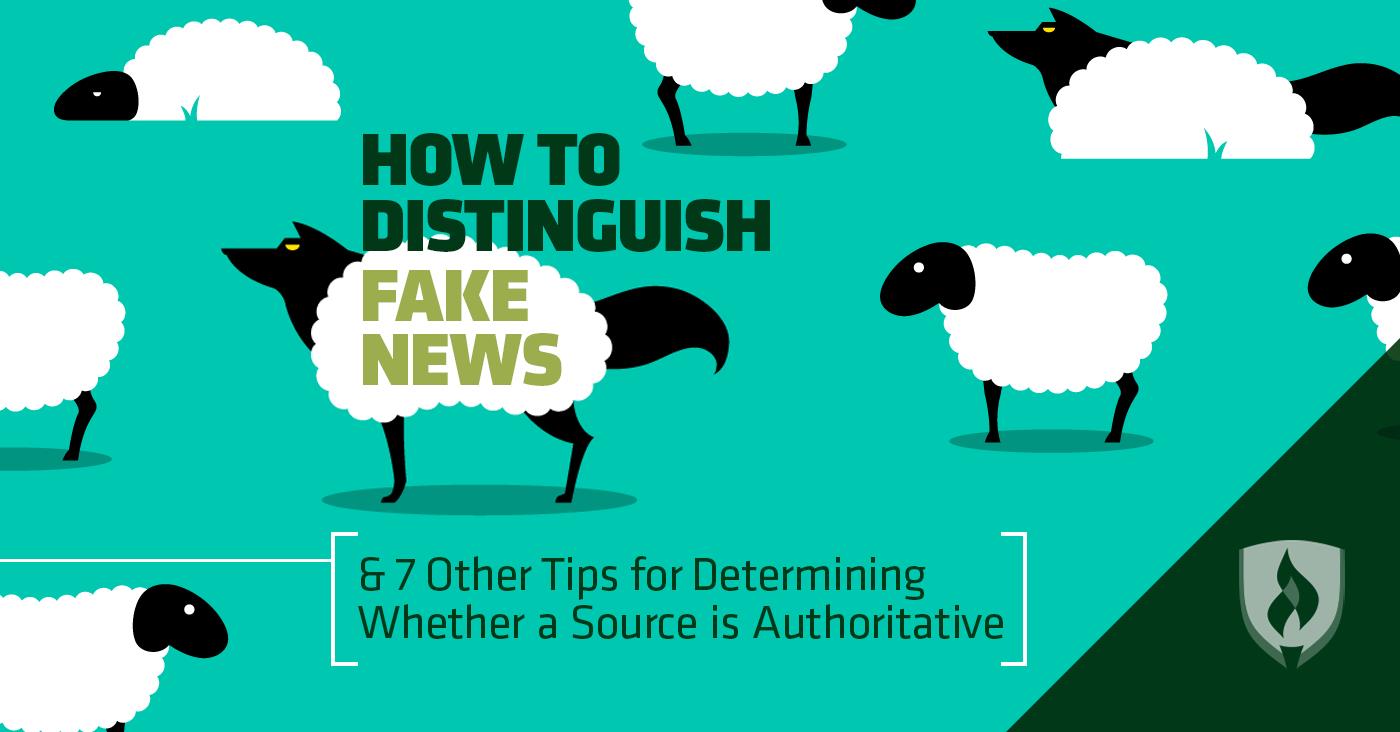How to Distinguish Fake News & 7 Other Tips for Determining Whether a Source Is Authoritative
By Jess Scherman on 03/08/2017

If you’ve paid any attention to national newscasts or your social media feeds, then you know that fake news is a huge topic of conversation as of late. The now infamous “Pizzagate” scandal has solidified the very real consequences that buying into fake news can yield. And yet, the creators of the fictional propaganda face virtually no penalties for publishing the falsities in the first place.
For college students tasked with crafting research papers and projects, these recent events bring to light an all too relevant question: How do you know whether the sources you’re using are indeed authoritative?
While instructors often require research to come from academic and scientific sources rather than mainstream media, academia has its own version of fake news, according to Cameron Clark, second-year law student at Harvard Law School.
“This includes articles that espouse new theory or practices that have yet to be critiqued or reviewed by peers in the field,” Clark explains. “Using information that has not been properly authenticated can have a detrimental impact on a student’s written product,” he adds.
With that in mind, we spoke with experts from a wide range of fields to learn their best tips for determining whether a source is authentic and credible. See if their tips can help you distinguish fact from fiction!
8 ways to determine a source’s authority
1. Learn how to spot fake news
“Because anyone can now post ideas and ‘news’ on the internet, all readers and listeners get flooded with a lot of both factual and false information,” explains Janet Heller, veteran professor of 35 years, acclaimed writer and respected literary critic.
While fake news has landed in the contemporary limelight due to ease of publishing on the internet, this is far from a new concept. In fact, Sarah Tippett, Editor of Homeschool Base, outlines its history dating all the way back to the 1830s. She even asserts that many of the identifiers of fake news from back then still hold true today.
Here are some of her suggestions for identifying fake news:
- Never believe what you read on your social media feeds without doing your own external research.
- Examine the rest of the website to get a feel for the type of content they typically publish.
- Check if the website has a comment section and see if anyone is disputing the legitimacy.
- Search for similar stories on other websites.
- Look it up on Snopes.
You can read more of Tippett’s tips on her website.
2. Re-evaluate what is considered “authoritative”
College instructors generally want students to use scholarly articles and books as resources for their papers and projects, as these are often works written by experts in the respective field. “In contrast, popular magazines like Time mostly publish essays written by non-experts who are just journalists. Such essays are not authoritative and may contain errors in facts or interpretations,” Heller says.
She explains further that in order to get a scholarly article or book published, writers must have their work “refereed” by experts in the field who have doctoral degrees. “This screening process guards against false information,” she adds.
3. Double check your “experts”
With that in mind, you may be wondering how you can be sure the writer of a piece you’re hoping to reference is truly an expert in his or her field. This task may not be as difficult as you’d initially expect.
“If someone claims to be an expert on a topic, you should be able to find them quoted on other websites or in other publications,” suggests Christina Nicholson, former TV reporter, current media specialist and owner of Media Maven.
Search the source’s name to see if you can find other credible publications that have relied upon their insights. You can also look to see if they have a website or a LinkedIn page, Nicholson adds. These platforms will often tout their accomplishments in the respective industry.
4. Ask a multitude of questions
As a rule, it can be helpful to always approach a new source as a bit of a skeptic, according to Pablo Solomon, artist, designer and futurist.
Solomon offers a number of questions you should ask of a new source. Among them are the following:
- Who is this person and what do they have to gain?
- Why is this topic being brought up now?
- Are there any organizations or political parties affiliated with the idea being presented?
- Who is financing this idea and why?
- Is this the only view out there? Is it disputed elsewhere?
- Does this idea attack the values held by a particular group of people?
Determining the answers to questions like these can help you uncover a potential hidden agenda buried within a particular source of information.
5. Avoid mainstream media in general
It can also be a good rule of thumb when you’re searching for authentic, credible sources to avoid news venues altogether. Even if it isn’t blatantly fake, Solomon asserts that all news is—to varying extents—biased or driven by a particular agenda. That is to say, mainstream media is likely not the most authentic resource in which to find objective viewpoints.
6. Seek resources that are peer-reviewed
Clark asserts that one of the best ways to ensure your research produces reputable and legitimate information is to find resources that have been peer-reviewed. “This means that the author’s article has been read, discussed and critiqued by others in the field in a relatively objective manner,” he explains. “Because everyone in the field wants to push research and knowledge further, they are likely to have a skeptical eye that works in favor of a researcher seeking to use the article,” Clark adds.
7. Find out how often the piece has been cited
Another sure way to check if your desired source is considered credible in its field is to see how often it has been cited by others. “Google Books and a number of other tools allow you to find out how often a paper has been published within the field,” Clark says. “This is particularly helpful, with or without peer review, because it establishes the article’s legitimacy over time.”
He adds that it can also be useful in providing leads for other articles that may prove relevant to your research.
8. Look into website authority
While many of the above tips require some industry-specific investigation, there are tools out there that can help you determine a resource’s authority on a more technical level. “A quick and easy way to “look under the hood” is to install the MozBar Chrome extension that shows you a site’s domain authority,” suggests Bryan Clayton, SEO whiz and CEO of GreenPal.
“This allows most anybody to quickly understand which sites are authoritative and which have manipulated their way into search engine rankings temporarily with fake news,” he explains. After you install this free tool, you can simply click the icon within your browser to receive various scores for page authority, domain authority and even a spam score. An authoritative source typically has a domain authority of 70 to 100, whereas less trustworthy sites will fall far below that range.
Put your best foot forward
You’re now armed with a number of expert tips to help you weed out fake news and determine which sources are authoritative enough to base your research on. Now it’s time to move forward with the various projects that await. Check out our article " Are There Legal Ramifications to Publishing Fake News Stories?"
Discerning fact from fiction is just part of the battle, as studying in an environment that isn’t conducive to your work style can take a huge toll on your productivity and the quality of your work. When it’s time to really put your head down and get some work done, be sure to reference the suggestions in our article, 12 Tips to Create the Perfect Study Environment for You.
RELATED ARTICLES:




